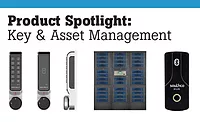Fostering Accountability Through Weapons Equipment Management

When it comes to managing sensitive equipment as a public safety officer, your firearms are some of the most high-risk assets you can leave improperly secured. While there’s been a lot of conversation in the media about how to use firearms responsibly, there are several best practices you can utilize to help ensure that they are only accessible to authorized personnel who are fully accountable for their use. Any solution you choose for managing your firearms should take the following into account.
Limit Firearm Access to Authorized Personnel
This sounds intuitive, but how are you controlling your firearm access, and does that process truly mitigate as much risk as possible? Who currently has access to your armory, and how do those individuals access their weapons? This is arguably the most important part of firearm security, so you should choose a solution that allows you to quickly and reliably restrict firearm access to clearly vetted individuals. Yet, they must have the ability to release quickly in the event of an emergency, while still maintaining that high level of accountability and security.
Also be aware of any potential risks with the methods you’re currently using. How well do your processes work with employee turnover, onboarding or contractors? Physical keys to a safe or an armory can be lost or misplaced, leaving you forced to rekey if one goes missing. Passcodes have to change and be redistributed when employees are fired or are only working short-term. Employee issue or “sign out sheets” always bear the risk or the human element and human error.
Another consideration is if your employees can access firearms outside of designated work hours. To safeguard your weapons properly, you should be able to restrict their access to only when it’s absolutely necessary, or at the very least, log the reason behind your firearm’s unscheduled use. Part of accomplishing that is discussed in our next best practice: record keeping.
Have Strict & Meticulous Record Keeping
Having a meticulous record kept of who has used your firearms, and when, is incredibly valuable, and in many cases required for compliance reasons. Not only does it give you a fully transparent view of your operations, but it helps keep your employees accountable for individual firearm usage, and helps keep everyone safe. You can either have a supervisor overseeing this, or automate the process with technology that immediately keeps track of firearm access and returns.
Record keeping shouldn’t just be about tracking who has firearms, but should also take into account which user has access to which specific firearm, during what times. You should never have a firearm missing whose user isn’t accounted for. By doing this, you put the bulk of responsibility on those who are using the firearms. When individuals know they are accountable, not only do they behave more responsibly, but it often translates to longer asset life.
This is especially true when the following best practice is included: fault logging.
Include Fault Logging in Your Records
Fault logging involves disclosing the status of a firearm when it’s returned. Does it have any loose or broken parts or components that need service or replacing? Is it malfunctioning or does it require cleaning? Is it due for a regularly scheduled function check? If the answer to any of the above is “yes,” then access to that firearm should be immediately restricted until the fault is resolved. The right solution will have the ability to automate this process and make it easy on the user to not disrupt the “day to day” of their work lives.
An important part of fault logging for firearms is making sure your team is up-to-date on identifying what broken or malfunctioning weaponry looks like. You can keep broken parts as training aids to help educate your employees so that all returned firearms are accurately labeled as in good or bad condition. You should also keep new components on hand to make replacement quick and easy.
Doing this helps your firearms last as long as possible, while improving safety for your personnel.
Whatever solution you rely on, make sure you’re working with a manufacturer who is responsive and supportive when it comes to answering your questions or meeting your needs. A manufacturer with experience in deploying many different types of locker projects, ideally integrated into your existing systems to minimize the administrative overhead, is going to pay dividends in the long run. If there is one thing that is certain, it’s that no two environments are the same, and a manufacturer with experience in customizing and navigating through a solution that fits your exact needs is priceless. The above are all good general best practices for managing your weapons equipment, but each company’s needs are different, and sometimes require more custom solutions. It’s never a bad idea to have a conversation with your team about how you can improve your weapon equipment management to focus on accountability and responsible firearm use.
Looking for a reprint of this article?
From high-res PDFs to custom plaques, order your copy today!








